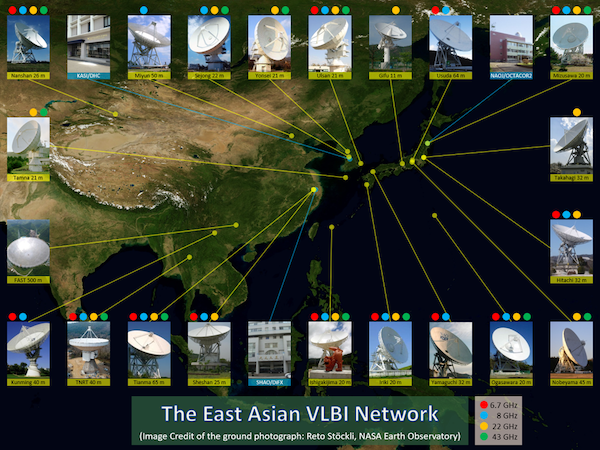
Concluding a new memorandum of understanding for the East Asian VLBI Network
by Kiyoaki Wajima (Korea Astronomy and Space Science Institute, East Asian VLBI Network Collaboration, Republic of Korea)

Japan, and Korea. FAST 500 m telescope, which is to be used for EAVN observations
at lower frequencies (< 1.6 GHz), and the Thai National Radio Telescope (TNRT),
which is under construction, are also included in the map. Photograph of each radio
telescope and correlator site are overlaid on ‘the Blue Marble’ image.
Credit of the ground image: NASA’s Earth Observatory.
The East Asian VLBI Network (EAVN) consists of 21 radio telescopes and three correlator sites located in East Asia and is operated mainly at 6.7, 22, and 43 GHz (see Figure 1). The EAVN started its open-use programme from the second half of 2018. Prior to launching the open-use programme, the current Memorandum of Understanding (MoU) has been concluded on 6 September 2018 between four institutes - Korea Astronomy and Space Science Institute (KASI), National Astronomical Observatory of Japan (NAOJ), Shanghai Astronomical Observatory (SHAO, China), and Xinjiang Astronomical Observatory (XAO, China) in order to promote collaboration on scientific research and technical development for the EAVN, as well as to operate the EAVN.
At the beginning of EAVN open-use programme in 2018, the programme was operated with 10 radio telescopes (KVN 21m x 3, VERA 20 m x 4, Tianma 65m, Nanshan 26m, and Nobeyama 45m). After that, 6 telescopes joined the program, the Takahagi 32m in the first half of 2020, the Hitachi 32m, the Yamaguchi 32m, and the Sheshan 25m in the first half of 2021, the Kunming 40m in the second half of 2021, and the Sejong 22m in the first half of 2022. This results in the EAVN growing into one of the biggest VLBI arrays in the world with 16 radio telescopes participating in the open-use program. In the second half of 2021, the EAVN provided a total observing time of 550 hours including target of opportunity observations and test observations for performance evaluation. In addition, some EAVN observations were conducted with non-EAVN telescopes in Italy, Russia, and Australia.
Radio telescope facilities and the radio astronomy community is spreading not only in East Asia but also in Southeast Asia, with the construction of the 40m radio telescope (Thai National Radio Telescope; TNRT) in Thailand, plans to convert a 32m telecommunication antenna into radio telescope in Indonesia, and a new 7m radio telescope operated by the Universiti Pendidikan Sultan Idris (UPSI) – Universiti Malaya (UM) Radio Astronomical Observatory in Malaysia. Especially, the commissioning of the TNRT 40m telescope will begin early in 2022 and the TNRT will participate in the EAVN open-use program in 2024 at the earliest. This will become a powerful upgrade of the EAVN thanks to its unique location.
These developments motivate us to update the current EAVN MoU by inviting three new institutes: Yunnan Observatories (YNAO, China), National Geographic Information Institute (NGII, Republic of Korea), and the National Astronomical Research Institute of Thailand (NARIT), all of which operate upcoming radio telescopes for the EAVN open-use program. A new MoU was concluded on 1 October 2021. This MoU will accelerate further practical collaboration in the wide fields of VLBI sciences in Asian region and become a key milestone in realising the Global VLBI Alliance.